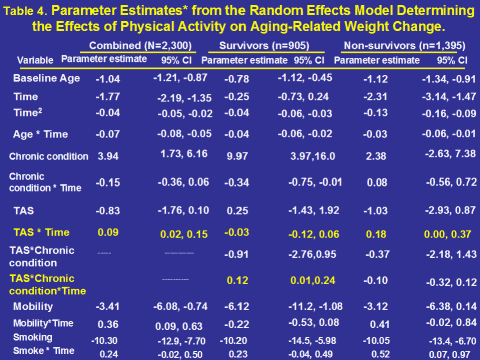 |
*also adjusted for
sex, race, education, height, functional disability score, and housing.
Here is the fully adjusted model, stratified by survival
status and containing all suspected confounding variables. Baseline age was
inversely associated with body weight as each year increase in age was
associated with a body weight lower by about 0.75 lbs in survivors and over
1 pound in non-survivors. Hence, older people started off the follow-up
period weighing less than their younger counterparts, and the magnitude of
this inverse association was greater in non-survivors compared with
survivors. The estimates for follow-up time and its second-order term
represent the markers for aging in this model. The negative
regression coefficients for the linear and quadratic terms among survivors
and non-survivors indicate a curvilinear slope for weight loss during
follow-up. Among the survivors, however, the magnitude of weight loss was
significantly dependent upon the presence of a chronic condition, whereas
the magnitude of weight loss among non-survivors was not. The statistically
significant quadratic term for "time" in the modeling suggests that the
amount of weight loss accelerated in both survivors and non-survivors
over the follow-up. As indicated by the interaction term between total
activity score and follow-up time (TAS*Time), each 1-unit increase in total
activity score significantly attenuated aging-related weight loss by
nearly 1 pound among the entire cohort. Again, however, the independent
relation between physical activity and attenuated weight loss is evident
primarily among those who did not survive. The 3-way interaction term among
physical activity, follow-up time, and chronic conditions was statistically
significant among the survivors, but not among non-survivors. Thus, among
survivors, physical activity attenuates weight loss ONLY in the presence of
chronic conditions, whereas among non-survivors, physical activity
significantly attenuates weight loss whether or not chronic disease is
present. |
